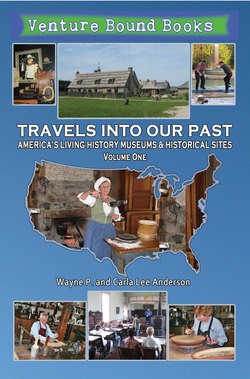Читать книгу Travels Into Our Past: America's Living History Museums & Historical Sites - Wayne P. Anderson - Страница 12
The Yorktown Victory Center
ОглавлениеThe battle at Yorktown, Virginia, was one of those “minor events” that had a major effect on history because it was the final straw that caused Great Britain to accept the existence of our new nation.
The Yorktown Victory Center, a newly renovated museum devoted to the American Revolution uses state-of-the-art exhibits to acquaint visitors with the Yorktown of Revolutionary days.
We were moved by the displays using the words of those who lived through the last major battle of the war in 1781, as recorded in their diaries, letters and other records. Visitors can gain an understanding not only of the events leading up to the Revolutionary War but its impact on ordinary men and women. For example, the visitor center’s movie on the battle has re-enactors speaking directly into the camera representing the experiences of the soldiers.
The Road to Revolution, a walkway to the main museum, includes descriptions of the events that led to rebellion. The personal experience theme is repeated in the museum displays. In one gallery titled “Witnesses to Revolution,” plaster casts of 10 people of different ages and backgrounds are spread throughout settings in three rooms. One is an older man standing in a cornfield, and another is a woman with her daughter fleeing the battle. As a spotlight hits each figure, a voice relates that person’s experience during the battle.
Another gallery, “Converging on Yorktown,” focuses on the many nationalities involved in the siege and the surrender of the British. Downstairs is the story of the ships lost or scuttled during the siege. A third gallery, “The Legacy of Yorktown: Virginia Beckons,” details how a new nation was created through the drafting of the Constitution with the Bill of Rights.
Plaster casts of a woman and her daughter fleeing the Battle of Yorktown.
Behind the main buildings is a Revolutionary War encampment with tents and officers’ quarters staffed with re-enactors. We were especially interested in a presentation on medical equipment and procedures. We gathered doctoring had not changed much from what we had read about medical practices in the 14th century. Purging and bleeding seemed to be standard, and no one knew what a bacterium was.
Re-enactors gave demonstrations on musket and cannon loading and firing. The presenters in costumes knew their roles well and answered questions as if they were someone who lived during that period.
A demonstration of the state of medicine at the time of the battle for Yorktown
A short walk away is a reconstructed farm of the period with chickens and turkeys roaming about. Two small buildings housed people in period costumes. Two young girls in one house seemed bored. We suspect they had originally thought it would be a lark to be the center of tourists’ attention, but with none of the modern entertainments or a smart phone they were used to having, time must have hung heavy.
With so many exhibits in the museum anyone going through all of them should deserve credit for completing a history course. The center is funded by the Commonwealth of Virginia and the Jamestown-Yorktown Foundation, a state agency that operates it.
